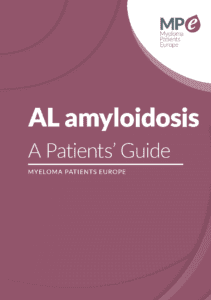What are the main AL amyloidosis treatments?
Since AL amyloidosis is a disease which manifests quite differently from patient to patient, treatment is highly individualised as well. The chosen treatment approach will largely be determined by the progression and severity of the disease, and by the affected organs. The two most important goals of treatment are 1) symptom management and 2) minimising or stopping the production of amyloid proteins.
By reducing light chains to normal levels, the direct toxicity is ameliorated, and organ-related symptoms such as heart failure may improve even if the Echo test shows no change.
Treatment options
Treatment approach depends on the type of amyloid deposit and on the underlining disease (if present). Although amyloidosis is not cancer, treatments may include the use of chemotherapy drugs that are mostly used to treat cancers. Organ or stem cell transplants are in some cases beneficial as well. As both myeloma and AL amyloidosis are caused by the presence of an abnormal plasma cell clone, drugs effective against myeloma may also benefit AL amyloidosis patients. To date, the only approved therapy specifically for the treatment of AL amyloidosis is the combination of the immunotherapy drug daratumumab and chemotherapy drugs cyclophosphamide and bortezomib with the corticosteroid dexamethasone (Dara-CyBorD). Further effective combinations that your doctor may recommend are bortezomib, the chemotherapy drug melphalan and dexamethasone (BMDex), as well as cyclophosphamide, bortezomib and dexamethasone (CyBorD).
An autologous stem cell transplant (ASCT) involves the use of your own blood stem cells to replace your bone marrow. This approach is often effective because it leads to the eradication of the plasma cells producing amyloid protein. ASCT can significantly prolong survival, though, only approximately 20% of patients qualify for this, as you need to be quite fit to safely undergo the procedure.
Reversal of organ damage, as well as the removal of amyloid deposits that are already present in tissues is challenging. However, there are some promising novel drugs in clinical trials that are designed to enable the removal of amyloid deposits (see Clinical trials section).
How is treatment response measured?
Treatment response is measured regularly, using the same types of tests that are applied to diagnose AL amyloidosis, including blood tests, urine tests, imaging and biopsies (see Diagnosis section) . It is important to recall that hematologic and organ response criteria are now based on biomarkers and validated criteria are defined.

Subscribe to
our newsletter!


